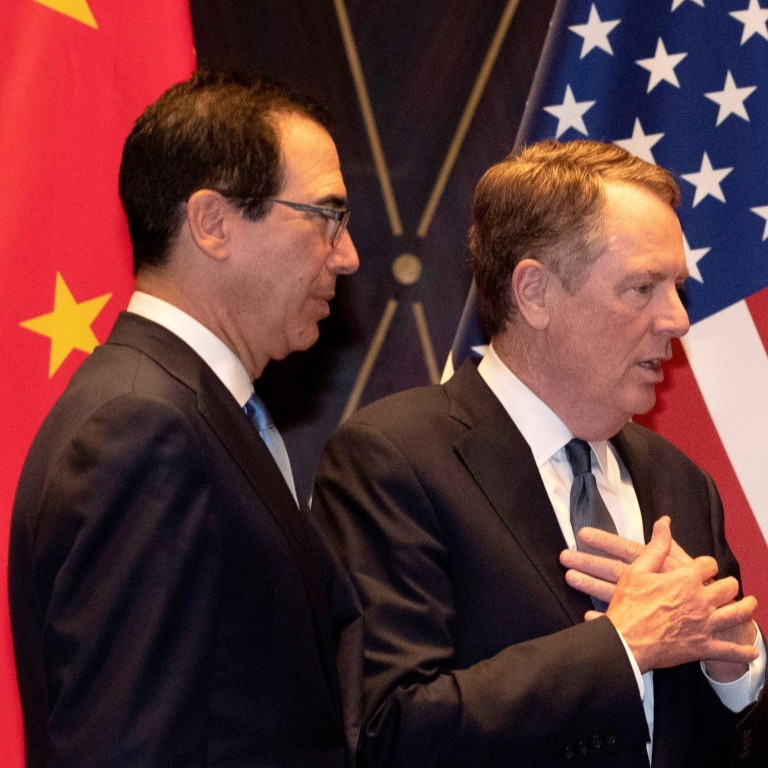
US-China trade: negotiators set to hold talks on progress of phase one deal
- Under general terms of agreement reached in January, officials are expected to meet every six months to assess its implementation
- But as tensions rise between Beijing and Washington, the commitment may have to take a back seat for now, observers say
The head of China’s trade negotiating team, Vice-Premier Liu He, and joint leader of the US side, Trade Representative Robert Lighthizer, are expected to hold talks in August, according to a person familiar with the issue, who asked not to be named.
US officials now call Xi ‘general secretary’, not ‘president’ – but why?
Under the general terms of the deal, which was signed on January 15 and took effect a month later – top-level talks should be held every six months.
The meeting will be “an important inflection point” to allow both sides to assess the progress of the deal, the source said.

However, if because of the prevailing tensions between Washington and Beijing, “there was less of an appetite for engagement at the moment”, the two sides might agree that a telephone conversation between Lighthizer and Liu on May 8 had satisfied the “meeting” clause of the deal, the source said.
The China-US relationship has been in free fall for much of 2020, with the two sides clashing on a range of issues, from the origins of the coronavirus to trade, Hong Kong, Xinjiang, the South China Sea and ideology.
At the start of the year, US President Donald Trump openly boasted of his achievements in securing the phase one deal, but his tone has since changed.
Close encounter between US-China militaries captured by radio amateur
“The trade deal means less to me now than it did when I made it,” he said during a press conference at the White House on Thursday.
“They [China] are setting records. Yesterday was a record corn day, they purchased more corn than any order ever and that went on for two or three days. And soybeans and all, but it just means much less to me. Can you understand that? It just means much less to me.”
A Chinese government adviser said he too thought a new round of trade talks was unlikely given the poor state of the relations.
China’s decision to close US consulate in Chengdu ‘driven by size’, observers say
“The trade topic has lost weight in the overall China-US relationship,” he said on condition of anonymity as he is not authorised to discuss the matter.
However, Chinese authorities responsible for economic and trade issues met on Thursday to discuss a number of related issues, including how to increase imports, the person said.
“We have already bought what we could [from the US], so any additional purchases would create difficulties.”
Jake Parker, vice-president of the US-China Business Council, said maintaining the momentum of the phase one deal was “more important than ever”, adding that China had made some progress this year by further opening up its financial markets to American firms.
“Continuing to move forward with licensing approvals will reinforce that China is faithfully implementing its trade commitments and ensure the commercial relationship remains a bulwark against any further deterioration of the overall US-China relationship,” he said.
Darin Friedrichs, senior Asia commodity analyst at StoneX Group in Shanghai, said China had already bought 6.1 million tonnes of US soybeans for the next marketing year, which begins on September 1.
Can the US-China relationship ever go back to the pre-Trump days?
“The last time we saw this was 2014, when China had bought 8.3 million tonnes of US soybeans by this stage of the year,” he said.
“Even in the pre-trade war years of 2015 or 2016, China had only bought 2 to 3 million tonnes by this stage, so this is way faster.”
Chen Long, a partner at Plenum, an independent research agency with offices in Beijing and Washington, forecast China’s soybean purchase this week would set a new record of 1.7 million tonnes.
“The fact China is still making agriculture purchases as promised in the phase one deal is one of the few reasons for optimism ... While the deal remains intact so far, it is by no means ironclad,” Plenum said in a report.
What is the US-China trade war and what’s inside the phase one deal
“Talk is better than no talk, though it is likely to be done as a matter of routine,” Chen said.
As well as the spike in soybean purchases, Chinese firms bought a record 1.76 million tonnes of corn on July 14.
However, Friedrichs said the increase in purchases might have more to do with profits than Donald Trump.
“China’s domestic corn market is pretty tight at the moment, the price is high and they may want to use up their import quotas,” he said.
“There is demand for soybeans too. You can get a good margin if you’re importing US beans and selling to Chinese crushers right now. The economics of it are fine.”


